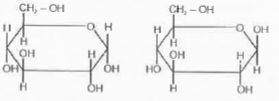The two cyclic hemiacetal forms of glucose differing only in the configuration of the hydroxyl group at C-1 are called
(a) Anomers
(b) Enantiomers
(c) Epimers
(d) Metamers
The correct Answer is:A
To answer the question regarding the two cyclic hemiacetal forms of glucose that differ only in the configuration of the hydroxyl group at C-1, we can follow these steps:
1. Understanding Hemiacetals:
- A hemiacetal is formed when an aldehyde reacts with an alcohol. In the case of glucose, the aldehyde group at C-1 reacts with the hydroxyl group at C-5 to form a cyclic structure.
2. Identifying the Cyclic Forms:
- Glucose can exist in two cyclic forms: alpha (α) and beta (β). These forms arise from the reaction of the carbonyl group (C=O) with a hydroxyl group (–OH) to form a ring structure.
3. Analyzing the Configuration at C-1:
- The difference between the two cyclic forms lies in the orientation of the hydroxyl group (-OH) attached to the anomeric carbon (C-1).
- In the alpha form (α-D-glucose), the hydroxyl group at C-1 is positioned downward (trans to the CH2OH group).
- In the beta form (β-D-glucose), the hydroxyl group at C-1 is positioned upward (cis to the CH2OH group).
4. Defining Anomers:
- The two cyclic forms of glucose that differ only in the configuration around the anomeric carbon (C-1) are known as anomers.
- Anomers are a specific type of epimer that differ in configuration at the anomeric carbon.
5. Conclusion:
- Therefore, the two cyclic hemiacetal forms of glucose differing only in the configuration of the hydroxyl group at C-1 are called anomers.
Final Answer:
The two cyclic hemiacetal forms of glucose differing only in the configuration of the hydroxyl group at C-1 are called anomers.
- A hemiacetal is formed when an aldehyde reacts with an alcohol. In the case of glucose, the aldehyde group at C-1 reacts with the hydroxyl group at C-5 to form a cyclic structure.
- Glucose can exist in two cyclic forms: alpha (α) and beta (β). These forms arise from the reaction of the carbonyl group (C=O) with a hydroxyl group (–OH) to form a ring structure.
- The difference between the two cyclic forms lies in the orientation of the hydroxyl group (-OH) attached to the anomeric carbon (C-1).
- In the alpha form (α-D-glucose), the hydroxyl group at C-1 is positioned downward (trans to the CH2OH group).
- In the beta form (β-D-glucose), the hydroxyl group at C-1 is positioned upward (cis to the CH2OH group).
- The two cyclic forms of glucose that differ only in the configuration around the anomeric carbon (C-1) are known as anomers.
- Anomers are a specific type of epimer that differ in configuration at the anomeric carbon.
- Therefore, the two cyclic hemiacetal forms of glucose differing only in the configuration of the hydroxyl group at C-1 are called anomers.
The two cyclic hemiacetal forms of glucose differing only in the configuration of the hydroxyl group at C-1 are called anomers.
Topper's Solved these Questions
- BIOMOLECULESBOOK - AAKASH INSTITUTE ENGLISHCHAPTER - BIOMOLECULESEXERCISE - Objective type question(Objective Type Questions (One option is correct))
5 Videos
- BIOMOLECULESBOOK - AAKASH INSTITUTE ENGLISHCHAPTER - BIOMOLECULESEXERCISE - Section-B (Objective Type Questions (One option is correct))
11 Videos
- BIOMOLECULESBOOK - AAKASH INSTITUTE ENGLISHCHAPTER - BIOMOLECULESEXERCISE - Try yourself
17 Videos
- AMINES BOOK - AAKASH INSTITUTE ENGLISHCHAPTER - AMINES EXERCISE - Assignment Section -J (Aakash Challengers Questions)
9 Videos
- CHEMICAL BONDING AND MOLECULAR STRUCTURE BOOK - AAKASH INSTITUTE ENGLISHCHAPTER - CHEMICAL BONDING AND MOLECULAR STRUCTURE EXERCISE - Assignment Section J (Aakash Challengers Questions)
10 Videos
Similar Questions
Two cyclic hemiacetal forms of glucose given below are called as

View SolutionCorrect the following statements by changing the underlined part of the sentence (Do not change the whole sentence).
α- D - glucose and β - D - glucose which differ in the orientation of hydroxyl groups C-1 are called epimers–––––––––,
View Solution
Knowledge Check
Glucose and galactose differ in configuration at:
AC–1BC-2CC-3DC-4
A pair of diastereomers that differ only in the configuration about a single carbon atom are called
View Solutionα−and β−Glucose differ in the orientation of the (−OH) group around:
View SolutionStructures which differ in configuration around C - 1 atom are called............
View SolutionDifferent forms of a gene are called
View SolutionThe process of formation of glucose form lipids is called
View SolutionPropane forms only one alkyl group.
View SolutionThe two forms of D-glucopyranose obtained from solution of D-glucose are known as:
View Solution
